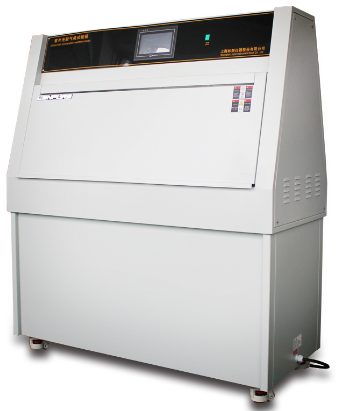Climatic Chambers for Test Standard DIN 75220: UV Chambers
This procedure is used to determine the ageing behaviour of polymer automobile parts in their original installed positions and mountings. It is applicable to complex assemblies or whole vehicles and is therefore particularly suitable for revealing interactions between different materials within one component or between several components. This standard needs a climatic chamber -- UV aging test chamber.
It is more complete than DIN 75202 in that changes of all properties relevant to use, such as shape, colour, gloss, feel to the touch, strength and the consequences of different degrees of thermal expansion resulting from exposure to artificial global radiation, heat/cold and moisture are evaluated.
All irreversible chemical and physical processes which take place over the course of time in a material. A solar simulation unit is a unit in which vehicles or components are exposed to artificial global radiation.
Artificial global radiation is radiation similar to global radiation which is used for test purposes; the values for its spectral energy distribution and radiation intensity at the reference plane are given in CIE publications No. 20 and No. 85.
The test chamber is a device in which the outdoor conditions on the external surfaces of a vehicle are simulated: outdoor conditions. The test box is a device in which the climatic conditions found in an enclosed car interior are simulated: indoor conditions.
The reference plane is an imaginary plane in the test chamber or test box in which the specified climatic parameters, such as radiation intensity, temperature, etc. are measured. A solar simulation unit’s useful test area is the area in which the specified climatic parameters are maintained.
Surface temperature is the temperature which is created by the artificial global radiation and heat exchange with the ambient temperature on the surface of the irradiated component. It is higher than the test chamber and test box temperatures.
Comment 1: In this standard surface temperature is characterised by the black standard temperature.
Comment 2: The temperature of the irradiated surface of the specimen is determined by the radiation conditions, the properties specific to the material and surface of the specimen and the heat transfer coefficient. Correct measurements are expensive or physically very difficult.
The test chamber temperature is the air temperature set by air stabilisation. The test box temperature is the air temperature set by air stabilisation. In the event of a test box being exposed to outdoor conditions, the test box temperature is a measured variable.
Specimens are complete vehicles, assemblies, components or sections of them. Test pieces are material specimens which are taken from the specimen before, during or after the test for evaluation.
Exposure zone 1 is a part of the car interior in which the components are subjected to intensive exposure due to their place of installation. Exposure zone 2 is a part of the car interior in which the components are only subjected to a small degree of exposure due to their place of installation.
Complete vehicle or external components are placed suitably in test chambers. Internal components are assembled as for installation and placed in test boxes. Radiation emitters, which generate an artificial global radiation, irradiate the specimens with a pre-specified radiation intensity at the additional climatic parameters. When the test is finished, the vehicle or the components in question is evaluated.
All the measuring devices listed below shall be suitable for recording the measured values. The measuring equipment shall be calibrated in accordance with the manufacturer’s instructions; but at least once a year.
Measuring devices shall only be acceptable if the manufacturer supplies information on the receiver’s temperature sensitivity and ageing and on the cos-accurate evaluation of the incoming radiation.
The following equipment shall be used to measure the radiation intensity E in W/m2 and, if required the irradiance, H in J/m2 :
a. In the spectral range 280<⋋<3000nm
This shall be measured using a pyranometer. A summary of radiation measurements during weathering may be found in ISO/TR 9673:1992 “Solar radiation and its measurements for determining outdoor levels of weather exposure”.
b. In the spectral range 280<⋋<400nm
Measuring devices with photoelectric receivers (term as defined in DIN 5030 Part 5) and suitable filters shall be used to take wideband measurements.
Comment: The manufacturer shall be provide information as to whether the photoelectric receivers are suitable for long-term measurements.
According to DIN 53387/04.89, subclause 5.2. Other measuring devices are permitted if they are shown to have equivalent characteristics. The current temperature in the chamber shall be measured continuously using one or several sensors which are not exposed to direct radiation. The temperature sensors used shall be expansion thermometers, thermocouples or, preferably Pt 100 resistance thermometers according to DIN IEC 751.
Sufficiently accurate humidity measuring devices inside the selected climatic area which can be read without influencing the air in the test area are suitable. The following are preferred:
- psychrometer according to DIN 50012 part 2
- LiCI hygrometer according to DIN 50012 Part 5
- capacitance-based humidity sensor.
The measuring probes shall be protected from exposure to direct radiation.
An additional check on the exposure conditions may be performed using reference materials whose ageing behaviour is well known. Standard shade 6 on the light fastness scale according to ISO 105-BO1, in dimension 45×30mm, backed with a 5mm thick polyester fabric or polypropylene foam is suitable.
There are two categories of test equipment according to the scope of application:
a. Test chamber for outdoor conditions as per Tables 2 and 5
b. Test box for indoor conditions as per Tables 3, 4 and 5
The main components of the test equipment are an irradiation unit, a temperature-adjustable test chamber and/or a text box to hold the internal fittings to be tested.

For more details, please feel free to contact sales@lenpure.com
Please visit www.lenpure.com











